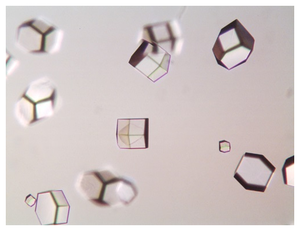Crystallization grade model protein
Mucopeptide N-acetylmuramoyl-hydrolase, Muramidase
| Cat. No. | Amount | Price (EUR) | Buy / Note |
|---|---|---|---|
| CO-401 | 5 ml | 77,40 | Add to Basket/Quote Add to Notepad |

For general laboratory use.
Shipping: shipped at ambient temperature
Storage Conditions: store at 4 °C
do not freeze
Shelf Life: 12 months
Molecular Weight: 14.3 kDa (single chain)
CAS#: 12650-88-3
EC number: 235-747-3
Form: aqueous solution
Concentration: 20 mg/ml
pH: 3.5 (H2O, 20 °C)
Solubility: 300 g/l in water
Activity: 50 kU/mg (Micrococcus luteus, FIP-Standard; pH 7.0; 25 °C)
Applications:
Lysozyme can be utilized as model protein in crystallization experiments and X-ray structure analysis.
Description:
Lysozyme is a glycosidase which hydrolyzes the ß 1,4 glycosidic bond between N-acetylmuramic acid and N-acetyl-D-glucosamine residues in the bacterial peptidoglycan[1].
Source: Chicken egg white
Usage:
Crystals can be grown using the sitting drop, hanging drop or microbatch method.
Following crystallization conditions are suggested for lysozyme crystal growth:
BIOZ Product Citations:
Selected References:
[1] Rye et al. (2000) Glycosidase mechanisms. Curr. Opin. Chem. Biol. 4:573.
[2] Gilliland et al. (2002) The Biological Macromolecule Crystallization Database: crystallization procedures and strategies. Acta Cryst. D 58:916.